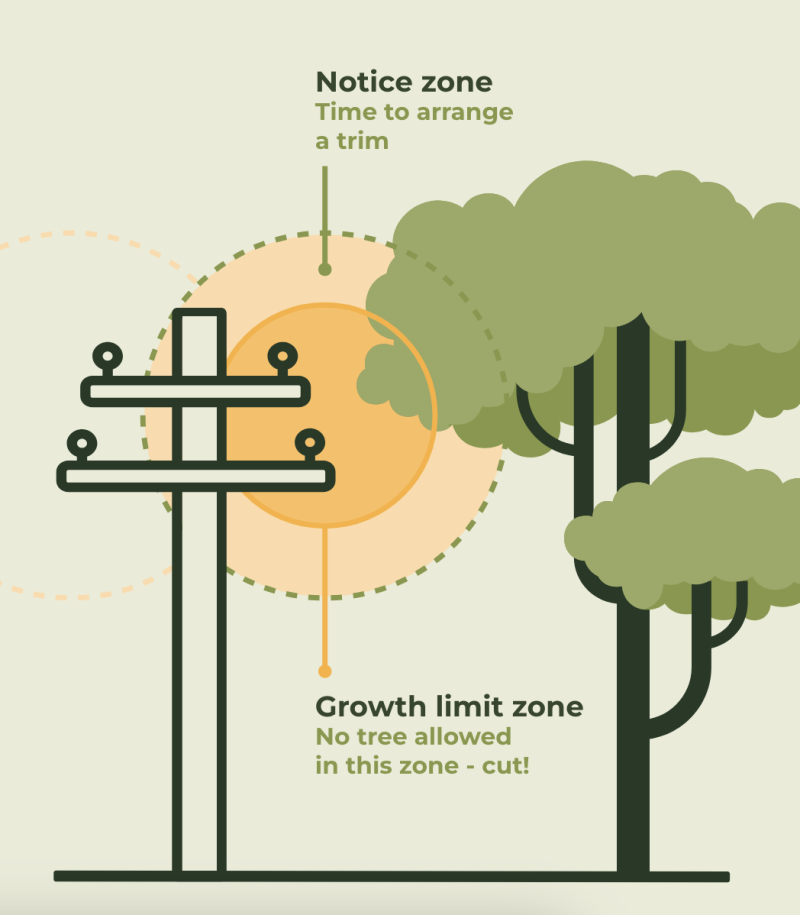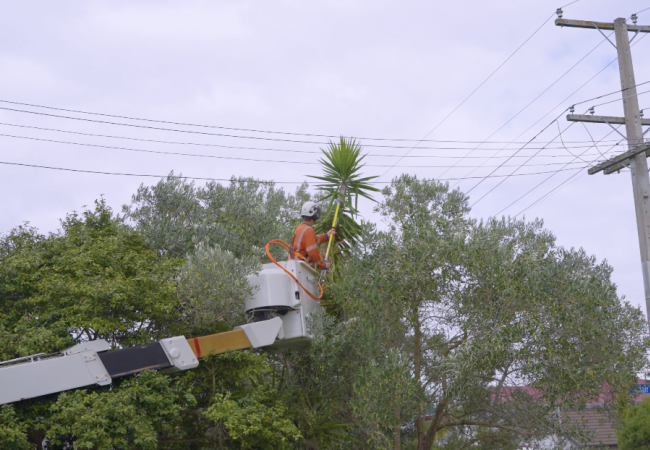Trees close to power lines are a safety hazard, with the potential for causing injury or death by electrocution. They are also a major cause of power outages. When conditions are dry, trees near power lines can cause fires. Trees can also damage power lines and equipment during high winds.
Overgrown trees also prevent our crews from repairing equipment quickly and can delay the process of restoring power to get our communities back up and running.
Check out this video which explains everything you need to know, and how you can help your community stay connected and safe:
Your obligations as a tree owner
Electricity network companies and tree owners must both comply with their obligations under the Electricity (Hazards from Trees) Regulations 2003. The purpose of these regulations is to protect the safety of the public and the supply of electricity.
A tree is your responsibility if you own the land it’s growing on. Under the regulations, trees must be kept clear of power lines, as shown on the right.
This page explains your responsibilities as a tree owner, including what happens when you receive a ‘hazard warning’ or ‘cut or trim’ notice.
We’re here to help you understand the regulations and your obligations, and to make sure overgrown trees don’t cause issues with power lines in our region.
For example, if a tree is on your property and growing into power lines, our team can undertake an inspection at your request. The tree may qualify for a free trim or removal, if we haven’t cut it before. Please see the full criteria below.

The different zones to know about
NOTICE ZONE — The notice zone extends one metre beyond the growth limit zone. If your trees reach this zone, you may receive a ‘hazard warning’ notice from Firstlight Network, cautioning you that the trees must not enter the growth limit zone.
GROWTH LIMIT ZONE — No part of a tree should be inside this zone. If you own a tree or other vegetation encroaching on this zone, Firstlight Network will notify you that the tree’s first cut or trim will be carried out free of charge. You must return the permission form allowing our contractor to undertake this work.
The notice and growth limit zones for trees vary, depending on the voltage of the lines nearby.
| OVERHEAD LINE | NOTICE ZONE | GROWTH LIMIT ZONE |
|---|---|---|
| High Voltage | ||
| 110kV | 5.0m | 4.0m |
| 50kV | 4.0m | 3.0m |
| 33kV | 3.5m | 2.5m |
| 11kV | 2.6m | 1.6m |
| Low Voltage | ||
| 400V/230V | 1.5m | 0.5m |
| Service main | 1.5m | 0.5m |
'Cut or trim' notice
To keep our lines working and safe for our community, we carry out regular surveys throughout the region and will issue a ‘Cut or Trim’ notice to owners of trees that have grown into the growth limit zone. If you’ve been sent a notice it means that your tree is dangerously close to live electricity lines.
Once you’ve received a notice, you have two options:
- Keep your tree and have it trimmed. You’ve been notified because your tree is growing close to live power lines. The first cut is free - the second time, you’ll need to pay.
- Remove the tree. If you don’t want to take care of keeping the tree at a safe distance from our lines, you can declare in writing that you have ‘no interest’. We’ll then decide whether to trim or fell it. See the full criteria below.
You must return the permission form allowing our contractor to either cut or trim the tree.
If you are a tree owner who is given notice to cut or trim a tree, and you fail to do so, or you fail to inform Firstlight Network of the time of the cut or trim, if convicted of an offence you could receive a one-off fine of up to $10,000. Plus, if the offence is a continuing one, you could receive further fines not exceeding $500 a day. You could also be liable for outage costs and power line repairs if damage has been caused by your trees.
Where a tree has come into contact with an overhead line or poses a serious hazard to the conductor, Firstlight Network may cut the tree as required, without notifying the tree owner.
Plant the right tree in the right place
The easiest way to avoid problems with trees and power lines is to choose the right tree for the right place in the first place:
- Before starting any new planting check for power lines and underground cables
- Do not plant large trees underneath or anywhere close to power lines. If you must plant something shrubs or low groundcover are best
- Trees grow big. Always check the plant size information. Understand what size your plant will grow to and then allow minimum clearance of at least 1.5 metres below the power lines and 3 metres to the side
- Many smaller native trees and shrubs are suitable for planting near power lines and still provide good shelter. Our favourite New Zealand natives include Akeake, Kawakawa (Pepper Tree), Manuka (Tea Tree), Mapau (also known as Red Matipo) and New Zealand flax.
Talk to our tree team
If you have any questions or need some advice, just give our tree team a call on (06) 869 0700.
You can return the online enquiry form here. Or, email us: trees@firstlightnetwork.co.nz
Firstlight Network approved tree contractors:
ATS GroupPh 027 395 9153 |
ArborCare Tree CompanyPh 06 862 5785 |
Eastland TreecarePh 06 862 5833 |
Roberts Tree SurgeonsPh 06 868 6463 |
Safety advice
Shelterbelts: If you have a shelterbelt on your property, keep trimming it as usual, but bear in mind the same rules apply as for trees near power lines. Talk to us, or one of our approved contractors, and make sure the trees don’t encroach on the notice zone. If your shelterbelt is within four metres of the power lines, you’ll need to use an approved shelterbelt trimming company or Network arborist. If the shelterbelt is too close, the power lines may need to be turned off for safety (at your cost) while the shelterbelt is trimmed.
Trees near conductors: For safety reasons, tree control work near conductors must be carried out by a Firstlight Network-approved contractor.
Private lines: Private overhead service mains connect some customers to our network through high voltage and low voltage overhead electric lines. The owner is responsible for the control of any trees close to these.
Overhead lines: Always treat all lines as live. If you’re working near overhead lines, check that there’s at least four metres clearance for any scaffolding or machinery. Be careful when you’re working on vehicles with raised apparatus, such as drills, grain augers and ladders. High voltage electricity can jump. Call us first and get the right advice before planning any building project, or starting evacuation work near overhead lines.
Fallen lines: Never approach fallen power lines. For your safety, stay at least 10 metres away. If a line falls in a vehicle, don’t touch the vehicle. If you see fallen lines, or trees on lines, please call the Firstlight Network 24/7 faults line immediately on 0800 206 207.
Electricity (Hazards from Trees) Regulations 2003, Clause 15, No-interest tree notice:
(1) An owner or occupier of any land on which a tree is growing may give a no-interest tree notice to a works owner if subclause (2), subclause (3), or subclause (4) applies.
(2) Subclause (1) applies if— (a) the tree was naturally sown in the vicinity of an existing works; and (b) the tree encroaches or may encroach the notice zone or growth limit zone in respect of a conductor belonging to the works owner; and (c) that conductor is situated on the land on which the tree is growing, or on the adjoining land.
(3) Subclause (1) applies if— (a) the tree was planted in the vicinity of an existing works before the commencement of these regulations; and (b) at the time of planting, the tree owner believed on reasonable grounds that the tree, when fully grown, would not interfere with any conductor.
(4) Subclause (1) applies if— (a) the tree was planted in the vicinity of an existing works on or after the commencement of these regulations; and (b) at the time of planting, the tree owner believed on reasonable grounds that the tree, when fully grown, would not encroach on a growth limit zone.
(5) An owner or occupier may give a no-interest tree notice whether or not the owner or occupier has received a hazard warning notice or a cut or trim notice in respect of the tree to which the notice relates.
(6) If an owner or occupier wishes to give a no-interest tree notice and the owner or occupier has received a cut or trim notice in respect of the tree to which the no-interest tree notice relates, the owner or occupier must give the no-interest tree notice no later than 10 working days after the date on which the tree owner received that cut or trim notice.
(7) A no-interest tree notice must be in writing and be given in the manner required by regulation 24.

